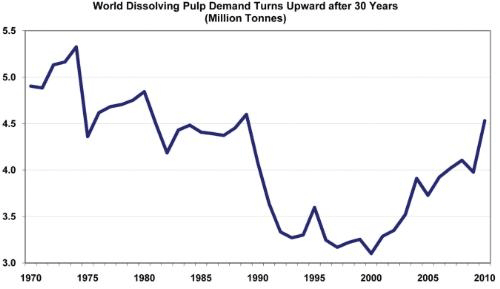World Demand for Dissolving Pulp Turns Sharply Upward
 Print this article | Send to Colleague Print this article | Send to Colleague
The global demand for dissolving pulp has increased sharply during the past decade, reaching 4.5 million metric tpy in 2010, according to a new study by RISI, Boston, Mass., USA, titled Outlook for Global Dissolving Pulp Market. As detailed in the report, annual demand for dissolving pulp reached its peak in 1975 at 5.3 million metric tons. It decreased over the next three decades, with a dramatic decline in the early 1990s due to the collapse of Communism in Eastern Europe. Demand reached its lowest point in 2000 at 3.2 million metric tons, but has increased dramatically over the past decade. Last year, demand for dissolving pulp again reached its pre-crisis level from 1990 of 4.5 million metric tons.

The big turnaround in dissolving pulp demand has been led by the viscose fiber market where the popularity of rayon, mainly for garment production, has been boosted by limited supplies and surging prices of cotton, the report notes. China, where dissolving pulp consumption for garment production has tripled over the past 10 years, accounts for all demand growth in the past decade.
Such strong demand and high prices have attracted pulp producers in the southern hemisphere to start new dissolving pulp lines, while in the northern hemisphere paper grade mills are converting to dissolving pulp.
"We're looking at getting a 10% addition to capacity in just one year -- an indication of how excited people are getting about this market," said Rod Young, chief economic advisor to RISI, and author of the study. "A big concern is that capacity keeps growing rapidly and we get into an overcapacity situation."
The main end uses of dissolving pulp are:
- Viscose fiber or rayon used in clothing
- Acetate tow and fibers used in cigarette filters
Ethers and microcrystalline cellulose (MCC) used in pharmaceuticals and as a food additive.
|
|

